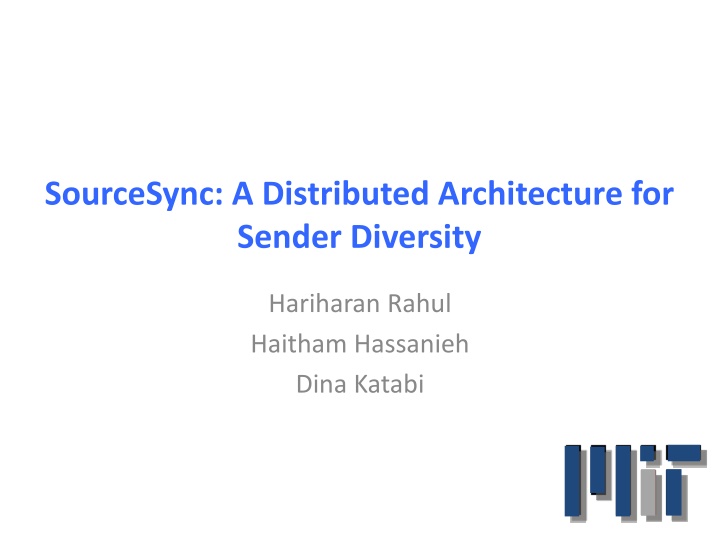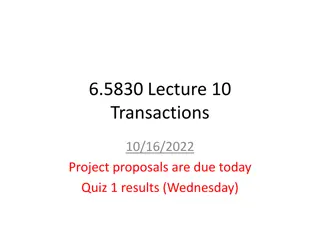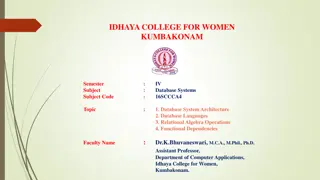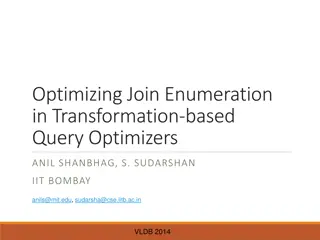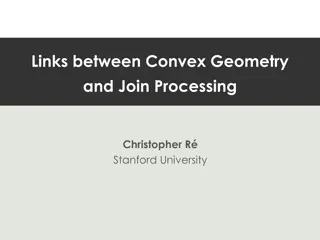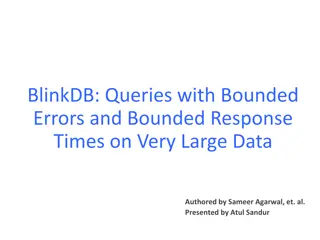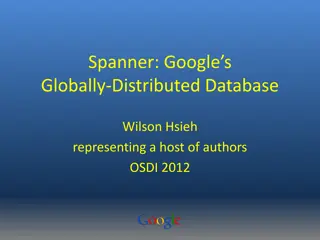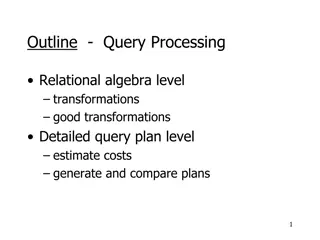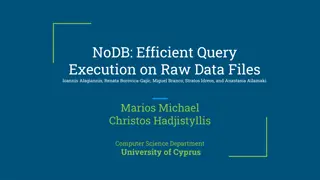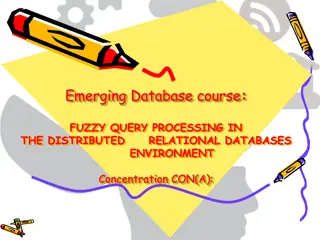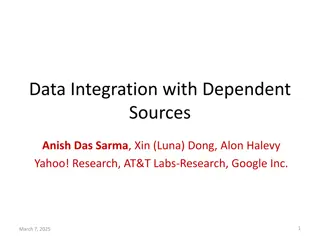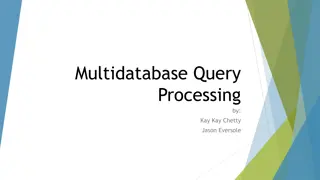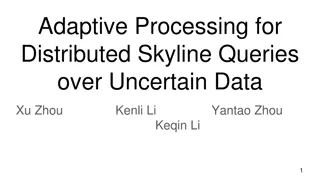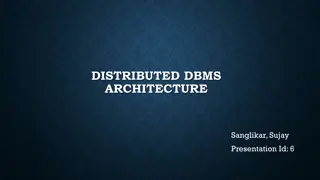Distributed Database Design and Query Processing Overview
This content provides insights into distributed database design, integration, semantic data control, query processing methodology, transaction management, data replication, and more. It discusses query decomposition, optimization, multidatabase processing, and current issues in the field.
Download Presentation

Please find below an Image/Link to download the presentation.
The content on the website is provided AS IS for your information and personal use only. It may not be sold, licensed, or shared on other websites without obtaining consent from the author.If you encounter any issues during the download, it is possible that the publisher has removed the file from their server.
You are allowed to download the files provided on this website for personal or commercial use, subject to the condition that they are used lawfully. All files are the property of their respective owners.
The content on the website is provided AS IS for your information and personal use only. It may not be sold, licensed, or shared on other websites without obtaining consent from the author.
E N D
Presentation Transcript
SourceSync: A Distributed Architecture for Sender Diversity Hariharan Rahul Haitham Hassanieh Dina Katabi
Diversity is a fundamental property of wireless networks
Receiver Diversity Sender Receivers Broadcast Unlikely paths to all receivers are attenuated at the same time
Receiver Diversity Underlies Many Systems All Opportunistic Routing Protocols ExOR, MORE, MIXIT, ROMER, SOAR, WLAN Diversity MRD, SOFT, Link-Alike, Vi-Fi,
Opportunistic Routing Exploits Receiver Diversity R1 Bob Alice R2 dst src R3 R4 Best single path Loss Probability is 25% Any router can forward Loss Prob. (0.25)4 < 1% Receiver Diversity Unlikely all routers see a loss
WLAN Diversity Exploits Receiver Diversity AP1 Uplink Client AP2 Ethernet AP3 AP4 Best Single AP Uplink Loss Probability is 25% Any AP can forward Uplink Loss Prob. (0.25)4 < 1%
Diversity is a fundamental property of wireless networks Receiver Diversity Sender Diversity Link-Alike ROMER MORE MIXIT SOAR SOFT MRD ExOR Vi-Fi
Sender Diversity Senders Receiver Transmit simultaneously Unlikely paths from all senders are attenuated at the same time
Diversity is a fundamental property of wireless networks Receiver Diversity Sender Diversity ? Link-Alike ROMER MORE MIXIT SOAR SOFT MRD ExOR Vi-Fi
Is it because Sender Diversity has no benefits? No Sender Diversity has analogous benefits to Receiver Diversity
Sender Diversity Improves Opportunistic Routing R1 Bob Alice R2 dst src R3 R4 Opportunistic Routing picks single router to forward
Sender Diversity Improves Opportunistic Routing R1 Bob Alice R2 dst src R3 R4 Opportunistic Routing Loss to Bob is 25%
Sender Diversity Improves Opportunistic Routing R1 Bob Alice R2 dst src R3 R4 Opportunistic Routing Loss to Bob is 25% Forward simultaneously Loss to Bob is (0.25)3 < 2% Sender Diversity Unlikely paths from all routers are attenuated
Sender Diversity Improves WLANs AP1 Downlink Client AP2 Ethernet AP3 AP4 WLAN Diversity Downlink Loss is 25% Forward simultaneously Downlink Loss (0.25)4 < 1% Sender Diversity Unlikely paths from all APs are attenuated
Is it because Sender Diversity has no benefits? No Sender Diversity has analogous benefits to Receiver Diversity Sender Diversity? What Has Prevented Us from Using
Challenge Today, simultaneous transmissions don t strengthen each other
Challenge Today, simultaneous transmissions don t strengthen each other R1 Interference Bob R2 dst R3 Sn Sn+1 Sn+1 Sn R4 Transmissions arrive out of sync Different symbols from different transmitters interfere Need Distributed Symbol-Level Synchronization
How Accurately Need We Synchronize? 3.2?? 2?? Symbol Misaligned Symbol 802.11 Symbol Time is 3.2?? Synchronization Error of 2?? Maximum Possible SNR is 10???10(3.2 2) = 2 dB
How Accurately Need We Synchronize? 3.2?? 1?? Symbol Misaligned Symbol 802.11 Symbol Time is 3.2?? Synchronization Error of 1?? Maximum Possible SNR is 10???10(3.2 1) = 5 dB
How Accurately Need We Synchronize? 3.2?? 1?? Symbol Misaligned Symbol 802.11 Symbol Time is 3.2?? For max. bitrate, 802.11 needs an SNR of ~22dB
How Accurately Need We Synchronize? 3.2?? 20?? Symbol Misaligned Symbol 802.11 Symbol Time is 3.2?? For max. bitrate, 802.11 needs an SNR of ~22dB Maximum Synchronization Error is 20 ns Need to Synchronize Symbols to within 20 ns
SourceSync Provides distributed and accurate symbol-level synchronization (within 20 ns) Complements Opportunistic Routing by harnessing sender diversity gains Complements WLAN Diversity by reducing losses on the downlink Implemented in FPGA and evaluated in a wireless testbed Talk is in the context of Opportunistic Routing Results apply to both Opportunistic Routing and WLANs
How Do We Synchronize Distributed Transmitters? Synchronize transmitters by reception
How Do We Synchronize Distributed Transmitters? Synchronize transmitters by reception R1 Bob Alice R2 dst src R3 R4 Routers are triggered by reception from Alice
How Do We Synchronize Distributed Transmitters? Synchronize transmitters by reception R1 Bob Alice R2 dst src R3 R4 Routers transmit jointly to Bob
How Do We Synchronize Distributed Transmitters? Synchronize transmitters by reception R1 Bob Alice R2 dst src R3 R4 Paths have different delays Signals arrive out of sync
How Do We Synchronize Distributed Transmitters? Synchronize transmitters by reception R1 Bob Alice R2 dst src R3 R4 Routers measure path delays and compensate for delay differences How do we measure path delays?
Components of Path Delays A new packet? R1 Bob Alice R2 dst src R3 R4 Propagation Delay Packet Detection Delay Hardware Turnaround Time from Rx Tx
Estimating Path Delays Propagation Delay Packet Detection Delay Hardware Turnaround Time from Rx Tx
Packet Detection Delay Receivers detect packet using correlation Random noise Do not detect packet on first sample Different receivers different noise different detection delay Peak Correlation Sample Index
Packet Detection Delay Receivers detect packet using correlation Random noise Do not detect packet on first sample Different receivers different noise different detection delay Peak Correlation Sample Index
Packet Detection Delay Receivers detect packet using correlation Random noise Do not detect packet on first sample Different receivers different noise different detection delay Peak Correlation Peak Sample Index
Packet Detection Delay Routers estimate packet detection delay Compensate for detection delay by syncing to first sample
Estimating Packet Detection Delay OFDM transmits signal over multiple frequencies 1 f1 0.8 0.6 0.4 Time (secs) 0.2 0 0 1.57 3.14 4.71 6.28 -0.2 -0.4 -0.6 -0.8 -1
Estimating Packet Detection Delay OFDM transmits signal over multiple frequencies First Sample 1 f1 0.8 0.6 f2 0.4 Time (secs) 0.2 0 0 1.57 3.14 4.71 6.28 -0.2 -0.4 -0.6 -0.8 -1 Detect on first sample Same phase
Estimating Packet Detection Delay OFDM transmits signal over multiple frequencies 1 f1 0.8 0.6 f2 0.4 Time (secs) 0.2 0 0 1.57 3.14 4.71 6.28 -0.2 T -0.4 -0.6 -0.8 -1 Detect after T Frequencies rotate at different speeds
Estimating Packet Detection Delay OFDM transmits signal over multiple frequencies 1 f1 0.8 0.6 f2 0.4 Time (secs) 0.2 0 0 1.57 3.14 4.71 6.28 -0.2 T -0.4 -0.6 -0.8 -1 Detect after T Different frequencies exhibit different phases Phase = 2 fT
Estimating Packet Detection Delay Phase Slope is 2 T OFDM Frequency f Each router estimates packet detection delay Estimate uses every symbol in packet Robust to noise
Estimating Path Delays Propagation Delay Packet Detection Delay Hardware Turnaround Time from Rx Tx
Hardware Turnaround Time Turnaround time is hardware dependent Different hardware pipelines Different radio frontends Each router locally calibrates its turnaround by counting the clock ticks
Estimating Path Delays Propagation Delay Packet Detection Delay Hardware Turnaround Time from Rx Tx
Measuring Propagation Delays Use Probe-Response between node pairs Probe A B Response RTT = 2 x Propagation Delay + Turnaround time at B + Packet Detection Delay at B + Packet Detection Delay at A
Synchronizing Distributed Transmitters R1 Bob Alice R2 dst src R3 R4 Routers are triggered by reception from Alice
Synchronizing Distributed Transmitters Compensate by waiting R1 Compensate by waiting Bob Alice R2 dst src R3 Compensate by waiting R4 Routers are triggered by reception from Alice Routers insert wait times to compensate for delay differences Routers transmit after waiting
Synchronizing Distributed Transmitters R1 Bob Alice R2 dst src R3 R4 Routers are triggered by reception from Alice Routers insert wait times to compensate for delay differences Routers transmit after waiting What about the MAC?
R1 R4 Alice dst src src R2 R5 dst David Bob Charlie R3 R6 Problem: Routers are forced to send upon reception even though the medium might be occupied Can We Synchronize While Using Carrier Sense?
SourceSync MAC Instead of triggering by reception from the previous hop, we trigger by transmission from one of the joint senders. All nodes in the network use CSMA. One of the nodes wins the contention and begins transmitting, just like in CSMA. Other nodes hear the transmission; join the transmission if they have the packet after inserting wait time.
Synchronizing Multiple Transmitters Sync Header Gap Data Lead Sender R1 dst Co-Sender R2 Lead sender: Transmits Synchronization Header Waits for known fixed gap Transmits data
